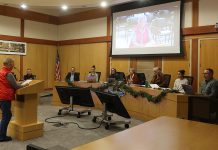
It took a few months, but the numbers are in.
Sonoma County released its point in time homeless census and survey results on June 26. The numbers show a 2% drop from last year with 2,951 people counted, 44 fewer than 2018.
The census was performed over the final days of January mainly driven by volunteers and those who recently transitioned from homelessness who served as guides.
The count took place during early morning hours and participants were told to not disturb those individuals believed to be homeless. Vehicles that were viewed as being lived in but which did not have a visible person in them were also counted.
After the count, a survey was conducted to see what trends or characteristics could be gleaned beyond the total number. There were 520 respondents to the survey, which the survey said gave them 95% confidence in extrapolating to the total population counted. Surveys concluded on Feb. 13.
Chronically homeless — those with disabling conditions who have been homeless for one year and/or experienced homelessness four or more times in the last three years — totaled 675 people. Of that, 20% were sheltered.
Sheltered is defined as “living in a supervised publicly or privately operated shelter designated to provide temporary living arrangement.”
This is the same definition used by the federal Department of Housing and Urban Development.
The survey compared the percent change of chronically homeless who were sheltered vs. unsheltered between 2013 and 2019 and found a total drop of 41%.
Most of those surveyed, 70%, had lived in Sonoma County for 10 or more years.
Before they became homeless, 87% of those surveyed lived in Sonoma County.
First-time homeless people made up 30% of those surveyed, down 5% from last year.
Demographics
There were 210 veterans in the survey, down from a high of 402 in 2011 and down one since 2017.
Of the 210 veterans, 68% were unsheltered, down 48% from 2013, the earliest data for the topic.
Most, 69%, identified as male, with less than 1% identifying as non-binary or transgender. Males made up 67% of the chronically homeless population, 30% female and 3% either transgender or gender non-binary.
By race, 65% of those surveyed were white, 19% multi-racial, 9% black and 6% American Indian or Alaskan native.
Chronically homeless were mainly white at 68%; 21% multi-racial individuals; with 5% or less in all other races provided.
Those who identified as Latino made up 28% of the total homeless population, 24% of the chronically homeless.
By sexual orientation, 82% reported being straight; 6% bisexual; 5% queer; and 4% lesbian/gay.
By age, 57% were 25 to 54 years old; 19% were 18 to 24; 15% were 55 or older; and 9% were under 18.
Youth Struggles
The survey’s introduction states that many youth homeless statistics are likely under-reported. It states that added focus on this area may have been part of the reason that, nationwide, point-in-time counts jumped 14% for youth in 2017.
“Young people experiencing homelessness have a harder time accessing services, including shelter, medical care, and employment. This is due to the stigma of their housing situation, lack of knowledge of available resources, and a dearth of services tailored to young people,” the report states.
Now the focus increases and the results have jumped even further.
“In Sonoma County, the number of unaccompanied children and transition-age youth increased dramatically,” the report states.
The number of unaccompanied children increased 344% to 117 from 34, and the number of transition-age youth (age 18-24) increased 17% to 549 from 471, compared to 2018. However, just a year before that, unaccompanied children totaled 116. In 2016, there were 367 transition-aged youth.
The total percent of unsheltered children was 97%, and 93% for transition-aged youth. This represented an overall drop of 41% in those sheltered compared to 2013.
Older adults
Older adults — those 55 and up — totaled 455 people. Of those, 62% were unsheltered, an 11% increase over last year.
Homeless factors
Most, 78%, were unemployed; 8% were employed part-time; 8% full-time; 6% were seasonally employed.
Of those unemployed, 36% said they were unable to work, 40% were looking for work and 24% were not looking for work.
Those considered disabled were 42% of survey respondents.
A total of 71% of those surveyed said they were receiving government assistance. Those who weren’t were asked why and 31% said they thought they weren’t eligible, 24% don’t want it and 15% reasoned they had no permanent address.
Non-government assistance was also surveyed by top response. Sixty percent said they received free meals. Almost half said they received bus passes (44%) and emergency shelter (40%).
The primary event that led to homelessness was split among four categories: lost job at 19%; argument with family or friend at 18%; alcohol or drug use at 16%; and eviction at 12%.
Health statistics were self-reported to show 38% abused drugs; 35% had psychiatric or emotional conditions and 25% had a physical disability. One-quarter reported they had post-traumatic stress disorder.
A total of 34% reported they had experienced domestic violence. Sixteen percent traded sex for shelter. Those who said they had been trafficked was at 7%.
Respondents were asked to list their top four obstacles to permanent housing. The top was not being able to afford rent, at 68%. No job/not enough income came in second at 48%; no money to move at 25%; and no housing available at 24%.
The report states there was a 3% drop in total housing stock due to recent wildfires.
General estimate
Using what the survey admits is a “volatile” formula, the county attempts to extrapolate what annual homelessness looks like.
The report notes the increased difficulty in calculating those who were homeless for under seven days, and so used a formula that was based on those who were homeless for at least one month.
For 2019, it is estimated that there will be 5,483 unique homeless experiences. This estimate shows a decrease from 2016.








